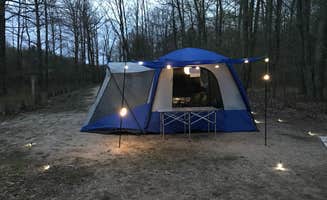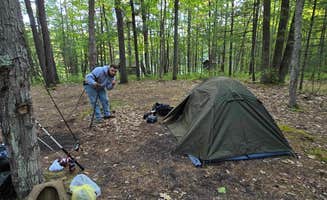Dispersed camping near Johannesburg, Michigan offers a range of primitive sites throughout the heavily forested landscape. The region spans over 900,000 acres of public land across the Huron-Manistee National Forest with elevations ranging from 700 to 1,100 feet. Summer temperatures average 70-85°F while spring and fall can drop to 40-60°F with significant precipitation, making preparation essential for weather variability.
What to do
Fishing opportunities: Clear lakes throughout the region provide excellent fishing. At Sand Lakes Quiet Area Backcountry Campsites, campers report exceptional fishing experiences. "Literally, some of the best fishing I have ever done. We caught so many bass we lost count. Well gave up counting. Like every other cast," according to Dan K.
Hiking trails: The interconnected trail systems allow for various hiking distances. "We walked this trail for 5 days and 4 nights. Cell service was spotty, which was the goal. Lots of wildlife and great views," writes Megan C. about her experience at Huron-Manistee National Forest. Trails range from short 1-2 mile loops to extensive multi-day backpacking routes.
Wildlife viewing: The region offers opportunities to see Michigan wildlife, particularly elk. "Beautiful lake, blessed by the Elk bugles nearby," writes camper J H. about their stay at De Cheau Lake Camping. Early morning and dusk provide optimal wildlife viewing times.
What campers like
Secluded campsites: Many dispersed sites offer significant privacy from other campers. "We didn't see another soul during our entire time there," reports Alyssa A. about their experience at Sand Lakes Quiet Area. Most dispersed sites are spaced 100-500 feet apart, allowing for private camping experiences.
Water access: Numerous camping areas provide direct access to lakes or rivers. "Absolutely serene and secluded in the gorgeous northern Michigan wilderness. The nature - forest, lake, and wildlife had me in tears," describes Maddy T. about her stay at Sand Lakes Quiet Area Backcountry Campsites.
Varied terrain: The undulating landscape offers diverse camping environments. "This forest area is unique because it offers large changes in elevation that you do not typically get in Michigan, especially not in the lower peninsula," notes Anna C. about Huron-Manistee National Forest. Sites range from riverside flats to elevated ridges with views.
What you should know
Access challenges: Many dispersed sites require navigation on unmarked or poorly marked trails. "We struggled to find this place and knew with the reviews it was possible. We ended up googling it on Google maps because the location on here was off," explains Rachael T. about finding Sand Lakes Quiet Area.
Permit requirements: Some areas require recreation passports or camping permits. "Posted on Southern entrance: Michigan Rec Passport Required," notes J H. about De Cheau Lake Camping. Permits can typically be purchased online or at ranger stations for $9-16 depending on residency status.
Limited facilities: Prepare for primitive conditions with few or no amenities. "Bring toilet paper. Water in stream is probably safe but bring a filter or enough water to last. No campgrounds, but there are areas with clearings for camping," advises Megan C. about backcountry camping in the area.
Tips for camping with families
Horse-friendly locations: Some areas specifically accommodate equestrian camping. "I camp here with my horse - there are plenty of trails and there is river access with big stairs leading down to the nice footed river," shares Brianna K. about her experience at Goose Creek Trail Camp, making it suitable for family trips with horses.
Mixed accommodations: Some sites allow vehicle access while maintaining a backcountry feel. "We had our car parked right up next to our site. We explored a bit walking around on the foot traffic trails, which is beautifully wooded and shaded," explains Alyssa A. about Sand Lakes Quiet Area.
Insect preparation: Bugs can be problematic in certain areas. "Campsites can be pretty buggy so bring your screens, hats and spray!" warns Angelia R. about Sand Lakes Quiet Area. Bug activity typically peaks from May through August, requiring appropriate protection for comfortable camping with children.
Tips from RVers
Site accessibility: While most dispersed sites are tent-focused, some areas accommodate smaller RVs. "Feels more remote than it really is. Lots of room for multiple vehicles/sites," notes J H. about their experience at Cut River Dispersed Campsite, which can accommodate larger vehicles despite its primitive nature.
Self-sufficiency requirements: RVers must bring all necessities as services are minimal. "Each site has its own fire pit and picnic table," mentions Lydia T. about Goose Creek Trail Camp, but most dispersed sites lack hookups, dump stations or other RV amenities. Plan to carry in all water and supplies and carry out all waste.



